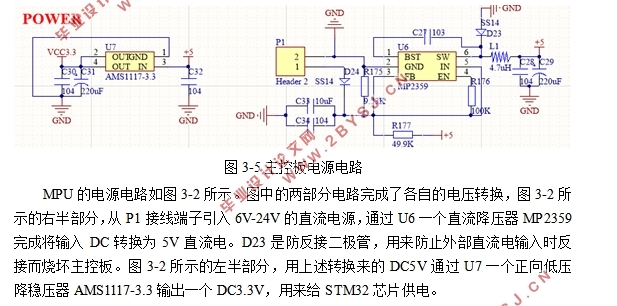基于STM32和LTC6804的电池管理系统设计(电路图,PCB图)
无需注册登录,支付后按照提示操作即可获取该资料.
基于STM32和LTC6804的电池管理系统设计(电路图,PCB图)(任务书,论文13000字,电路图,PCB图)
摘要
随着电动汽车的发展,锂离子电池因其充放电倍率高、循环寿命长、能量密度高、无污染的优点得到了广泛的应用。为了提高锂离子电池的使用效率,延长锂离子电池组的使用寿命,电动汽车运行过程中就需要电池管理系统对电池组的主要参数进行实时监测。
本文设计了基于STM32MCU和LTC6804电池组监测芯片的电池管理系统。通过一线总线结构的DS18B20芯片完成对电池组温度的监控,用霍尔传感器完成电池组电流的检测。使用LTC6804可以监测12个单体电池的电压,并可实现电池的均衡功能通过对电池组关键参数的采集,用电压、电流、温度的实时监测,完成对锂电池SOC的估算。
关键词:锂离子电池电池管理系统 LTC6804 SOC
ABSTRACT
With the development of electric vehicles, lithium-ion batteries have been widely used due to their high charge-discharge rate, long cycle life and no pollution. In order to improve the use efficiency of lithium-ion batteries and prolong the service life of lithium-ion battery packs, the battery management system is required to monitor the main parameters of the battery pack in real time during operation of the electric vehicle.
This paper designs a battery management system based on STM32 microcontroller and LTC6804 battery pack monitoring chip. The LTC6804 can monitor the voltage of 12 single cells and realize the battery equalization function. The battery pack temperature is monitored by the DS18B20 chip of the one-wire bus structure, and the battery current is detected by the Hall sensor. Through the collection of key parameters of the battery pack, real-time monitoring of voltage, current and temperature is used to complete the estimation of the SOC of the lithium battery.
Key Words:lithium-ion,battery management system,LTC6804,SOC
系统分析与设计方案
2.1 系统设计要求
锂电池采用新型21700电池,电池21700是圆柱型电池的型号,具体指:21指圆柱电池的外径为21mm;700指圆柱电池的高度为70.0mm。21700电池的单体电池容量可以达到3~5Ah,21700电池系统能量密度在300Wh/kg左右。
BMS对电池组的单体电压、电流、温度实施监测,所以BMS的输入信号有电压信号、温度信号、电流信号。本次设计的BMS监控对象是由20串18并构成的电池包。采集电池组的电压、电流、温度,通过CAN总线将采集的输入信号传送给上位机实时显示,通过MCU判断电池的荷电状态SOC,并根据单体电池的电压差值判断单体电池是否需要均衡。
每节锂离子电池工作电压为3.6V,一串锂离子电池组由20个单体电池串联而成,电池组的总电压为72V,单体电压采集20路,18并中的任一支路的20个锂离子电池的单体电压,单体电池的充电截止电压为4.2V,放电截止电压为3.0V,电压变化范围为3.0~4.2V。
每节单体电池的额定容量为5Ah,20串18并锂电池的额定容量为1800Ah,放电倍率1-3C,通过锂电池组带动额定功率为5kw,额定电压为72v的电机,放电电流约为69.4A,充电倍率为0.6C,在主线路上采集电流信号采集1路电流,用采集的干路电流除以18即可得到每个支路的电流值。
常规的锂电池工作温度为-20℃~60℃,锂电池性能完全的工作温度常见是0℃~40℃,采集18路温度(每一20串电池组的对应温度),温度范围为-20~60℃。


目录
第1章绪论 1
1.1 研究背景、目的与意义 1
1.2 电池管理系统的国内外研究历史与现状 1
1.3 课题研究主要内容及章节安排 2
第2章系统分析与设计方案 4
2.1 系统设计要求 4
2.2 整体结构设计 4
2.3 传感器选型 5
2.3.1 电压传感器的选型 5
2.3.2 温度传感器的选型 6
2.3.3 电流传感器的选型 7
第3章硬件系统的设计 8
3.1 主控板硬件设计 8
3.1.1 单片机最小系统 8
3.1.2 控板电源设计 10
3.1.3 CAN接口电路设计 10
3.2 采集板硬件设计 11
3.2.1 电流采集电路 11
3.2.2 单体电压采集及均衡管理 12
3.2.3 隔离式SPI通信 13
3.2.4 LTC6804供电电路 14
3.2.5 温度采集电路 15
第4章软件系统的设计 17
4.1 主程序设计 17
4.2 SOC估算算法 17
4.3 均衡模块程序设计 19
4.4 LTC6804程序设计 20
4.4.1 LTC6804初始化程序设计 20
4.4.2 电压检测程序设计 21
4.5 温度传感器程序设计 22
4.5.1 DS18B20初始化程序设计 22
4.5.2 温度检测程序设计 23
4.6 CAN通信程序设计 24
第5章总结与展望 27
5.1 全文总结 27
5.2 展望 27
参考文献 28
致谢 30
